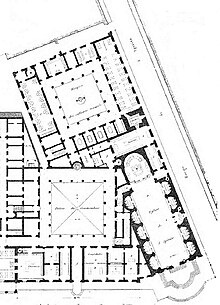Santo Spirito in Sassia
| Santo Spirito in Sassia | ||
|---|---|---|
Style Renaissance | | |
| Groundbreaking | 1538 | |
| Completed | 1545 | |
| Clergy | ||
| Cardinal protector | Dominique Mamberti | |
| Part of a series on the |
| Divine Mercy |
|---|
 |
| Forms |
| People |
| Places |
| Other |
Church of the Holy Spirit in the Saxon District (
History

The church stands on the site of King Ine of Wessex's Schola Saxonum, or "Saxon School", a charitable institution for West Saxon pilgrims. According to Roger of Wendover, Ine founded the Schola Saxonum in AD 727.[1] It included a hostel and a chapel dedicated to Santa Maria. In mediaeval times a substantial number of pilgrims from Wessex, including fighting men, traveled the Via Francigena from Canterbury to Rome.[2]
The hospice and church were gutted by fire in 817, were sacked by Muslim raiders in 846, and were again burned in 852.
In the stational procession for the first Sunday after the Octave of the Epiphany, instituted by Pope Innocent III (1198–1216), a procession carried the veil of
The inscriptions found in Santo Spirito in Sassia, a valuable source illustrating the history of the church, have been collected and published by Vincenzo Forcella.[4]
Art and architecture

The church has a single nave, and ten apsidal chapels along the sides. The counter-facade has a Visitation (1545) by
Burials
Cardinal-Deacons
Since the 1991 consistory of Pope John Paul II, the church has been used as a Deaconry with a Cardinal assigned as its Cardinal Protector (a term created by Pope Paul VI in 1966).
- Fiorenzo Angelini (28 June 1991 – 22 November 2014)
- Dominique Mamberti (14 Feb 2015 – present)
See also
- Basilica of Sant'Elia, a church in Castel Sant'Eliawhose monastery was held by the Canons of Santo Spirito in Sassia.
- Ospedale di Santo Spirito in Sassia.
References
- ^ Reader, Rebecca (1994). "Chapter Three: Matthew Paris and Offa of Mercia". Matthew Paris and Anglo-Saxon England: a thirteenth-century vision of the distant past (PhD). Durham University. Retrieved 12 May 2018.
- ^ Merkle, Benjamin R. (2009-11-02). The White Horse King: The Life of Alfred the Great (Kindle Locations 266-275 and 366-370). Thomas Nelson. Kindle Edition. (Nashville Tennessee: Thomas Nelson Co. 2009)[self-published source?]
- ^ "Churches of Rome". www.churches-of-rome.info. Retrieved 2023-12-11.
- ^ V. Forcella, Iscrizioni delle chiese e d'altri edifici di Roma, dal secolo XI fino al secolo XVI Volume VI (Roma: Fratelli Bencini, 1875), pp. 377-505. [in Italian and Latin]
Sources
- Emilio Lavagnino, La chiesa di Santo Spirito in Sassia: e il mutare del gusto a Roma al tempo del Concilio di Trento (Rome: Banco di Santo Spirito, 1962).
- Louise Smith Bross, The Church of Santo Spirito in Sassia: A Study in the Development of Art, Architecture and Patronage in Counter Reformation Rome [PhD thesis, University of Chicago, 1994].
- Sivigliano Alloisi and Luisa Cardilli Alloisi, Santo Spirito in Saxia (Rome: Istituto nazionale di studi romani, Palombi Editori 2002).
- Gianfranco Grieco and Jòzef Bart, Santo Spirito in Sassia (Gorle: Elledici: Editrice Velar, 2007). [available in English]
